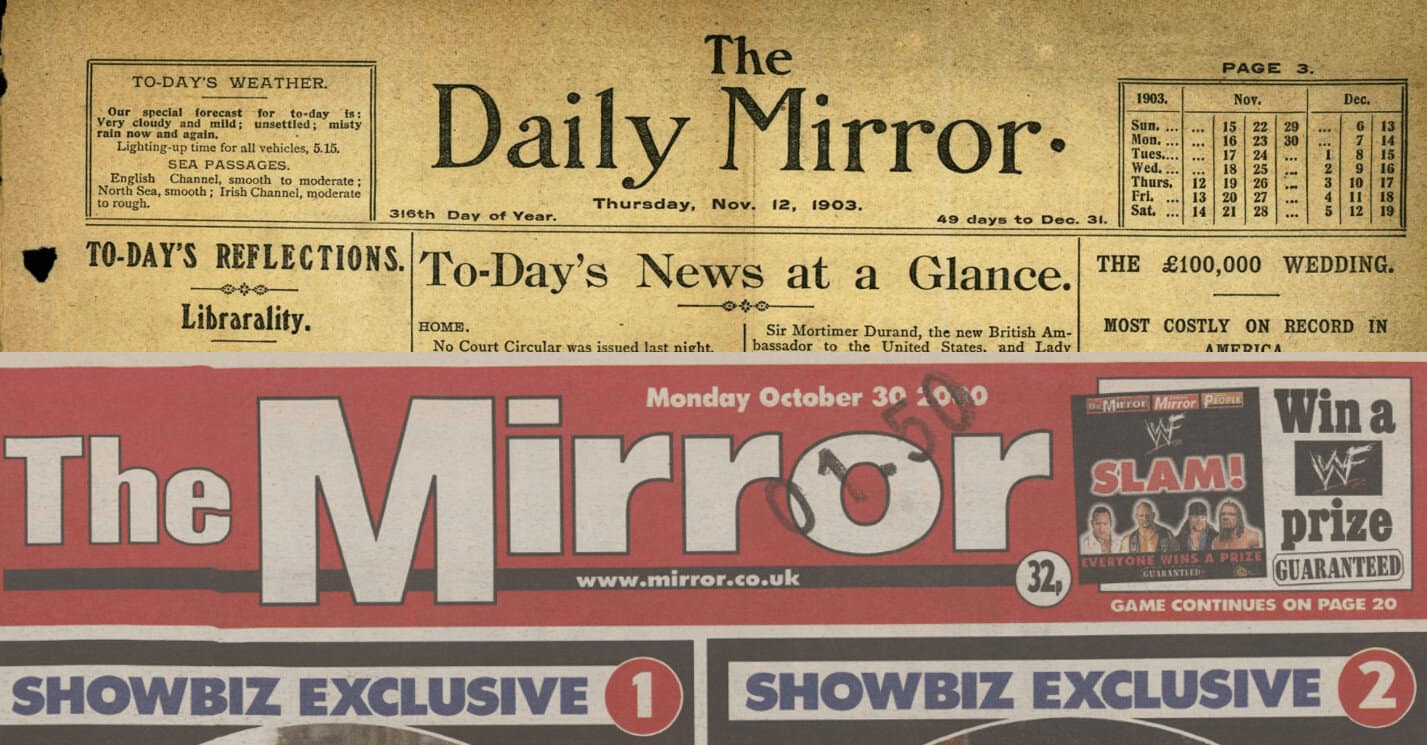│By Rebecca Bowden, Associate Acquisitions Editor, Gale Primary Sources│
From its inception in 1903, the Mirror has played a pivotal role in the history of British journalism, and today is the only mainstream, left-wing tabloid remaining in the UK. The newspaper has had a history of highs and lows, peaking in 1967 with a daily circulation of 5.25 million; understanding that history is an essential part of understanding British historical journalism. The Mirror not only played a prominent role in shaping newspapers as we know them today, but also acts as a distinctive counterpoint to the more conservative reporting in much of Britain’s mainstream press.
At the start of the twentieth century, newspaper magnate Alfred Harmsworth built on the successful launch of the Daily Mail for lower-middle-class audiences and started the Mirror as a newspaper written by women, for women. This approach, however, was a commercial failure. Realising that he’d misjudged the market, Harmsworth tried a different approach, transforming the Mirror into an illustrated paper by taking advantage of the latest technical developments of the time. By combining pioneering photography and human-interest stories, Harmsworth transformed the newspaper from failure to success.
A few years later the newspaper entered a rocky period as the take-over by Lord Rothermere in 1914 saw the editorial position shift to support fascism. By 1934, the Mirror was very much in need of a change of direction and this came in the form of an influx of new personnel. Under the leadership of Harry Guy Bartholomew, the Mirror became the paper of the working man through the use of bold, sensational and explicit stories – an approach that was heavily influenced by the success of American tabloids. During this period, sales rose significantly, helped by the success of Norman Pett’s famous and saucy Jane comic strip. This success continued into the 1960s, when the Mirror represented one of the most influential expressions of British popular print culture. In the latter decades of the twentieth century it faced increased competition from Rupert Murdoch’s The Sun, leading to a “battle of the red tops”, as it was referred to, in a nod to both papers’ red mastheads.
How an editorial stance affects reporting
A good understanding of the Mirror and its history is essential to unpicking British historical journalism, but so is an understanding of how a paper’s editorial stance affected reporting. The Mirror, as a left-wing tabloid that was often critical of political leadership and established parties, provides an alternative voice to many of the other titles available in Gale’s historical newspaper programme. It is only by comparing stories across multiple newspapers, and combining all of these voices and viewpoints, that researchers are able to create a 360-degree picture of historical events.
In comparison with the Daily Mail
This is best demonstrated through a direct comparison of the Daily Mirror with its right-wing competitor, the Daily Mail. Launched in 1896, also by Alfred Harmsworth, the Daily Mail presented itself as the representative of the hard-working middle-classes and was an important channel of public opinion. From its inception it followed three main editorial stances: a consistent opposition to left-wing politics; support for a strong and internationally respected Britain; and a social and cultural defence of “family values”. From the 1940s it consistently backed the Conservatives and from 1971 onwards, was a committed supporter of Margaret Thatcher, regularly and vigorously attacking labour and the trade unions. After Thatcher’s deposition in 1990, its support for the Conservatives became more muted, although did not disappear. Throughout its lifetime, the Daily Mail has drawn on bold, sensational headlines, at first so very different to the heavy, serious fare offered by Victorian morning papers, and has aimed to provide clarity and easy access to politics for the British public.
Comparing coverage of the armistice ending WWI
Though both newspapers originated with the same man, the differences in their approach are apparent, even very early on. Take a look, for example, at the issues for the November 12, 1918 – the day after the armistice ending World War I was signed.
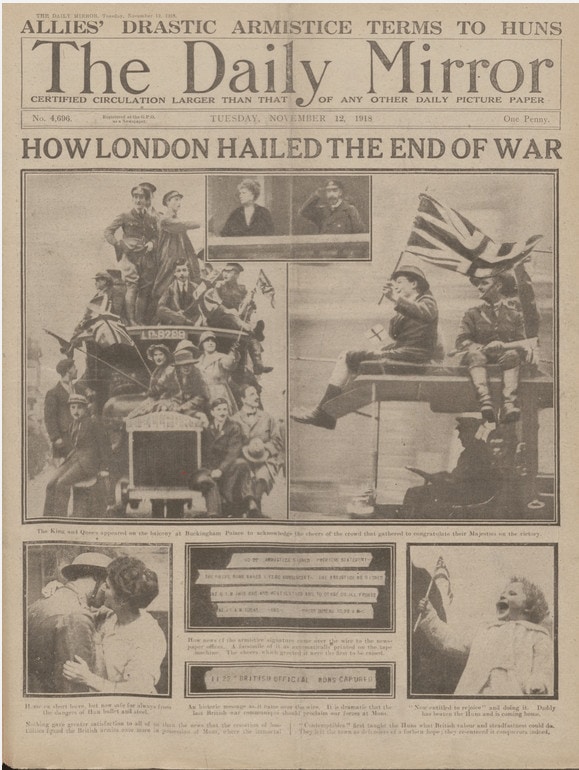
The front page of the Mirror is taken up by large images of celebrating troops and civilians, each with only a brief caption. The story itself comes only from the bold headline at the top: ‘How London Hailed the End of the War’. The images of couples kissing and smiling children proudly waving flags easily capture the joy of the time, requiring little additional input from the reader to understand what the paper is trying to evoke. The bulk of the story is instead reserved for the second page.
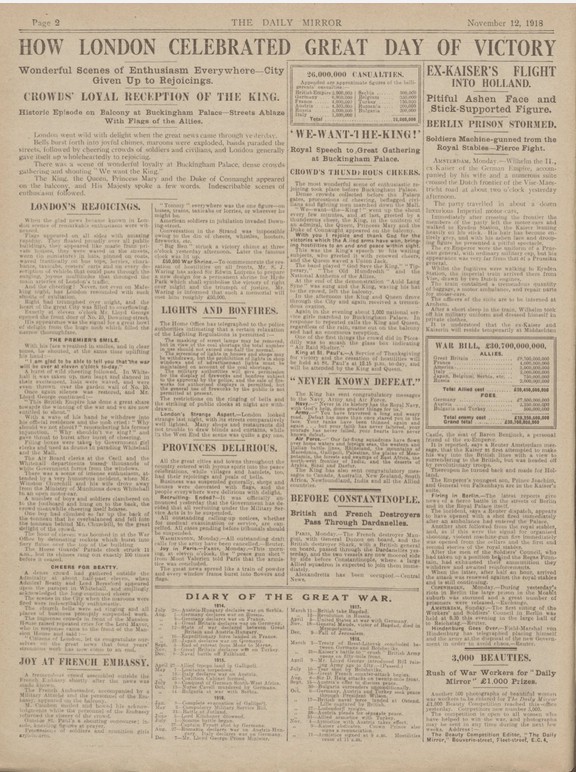
This is indicative of the Mirror’s editorial approach at the time, relying heavily on photography to draw the reader in. A “human-interest” focus has also been taken when producing coverage of the end of the war. Rather than political reporting on the events leading up to and the terms of the armistice, the focus here is people: the joyous reaction of the populace to the happy news the day before. Photography, and a more light-hearted reporting style, continue to dominate throughout the eight-page issue.
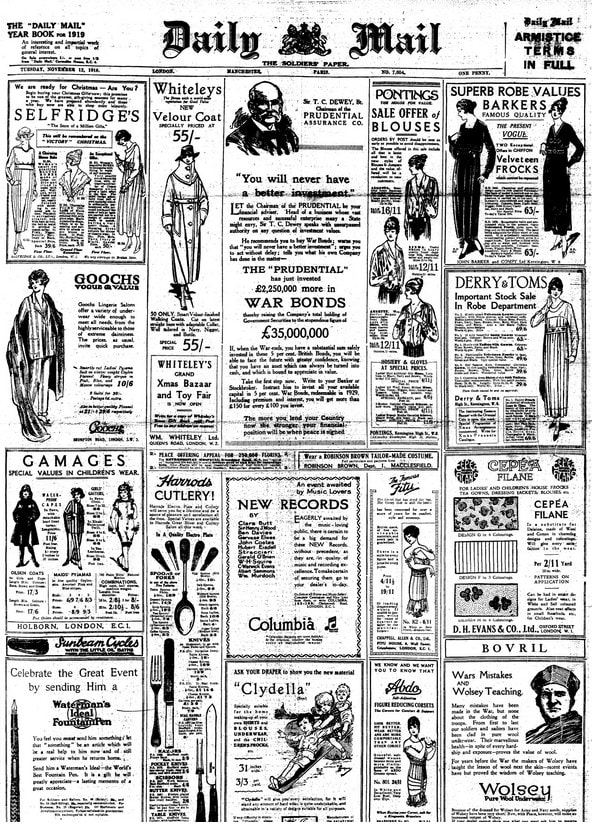
The Daily Mail on the other hand, takes a more traditional approach to journalism when reporting on the same event, although both newspapers did draw on the sensationalist style of American journalism. Unlike the Mirror’s front cover, which is dominated by photography, the Daily Mail dedicated almost its entire cover to advertisements, as it did for every cover of the time. The front page was the most lucrative advertising space in the entire newspaper and was reserved wholly for such a purpose until the outbreak of Word War II in 1939. The reporting itself is left for the second page, where the headlines reads: “Germany Surrenders”.
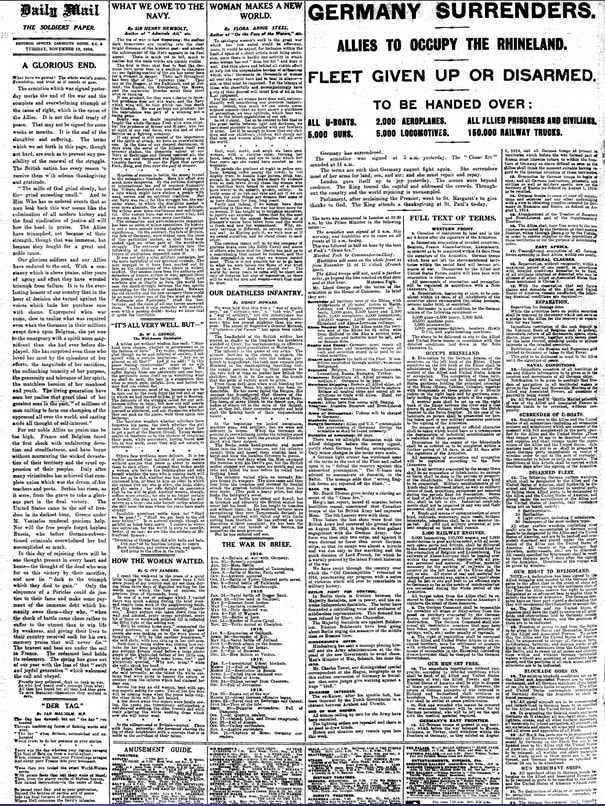
The story here is much more practical than the coverage provided by the Mirror – indeed, only a short line is given to the response of the people: “London gave itself up to joy yesterday. The scenes were beyond credence”. The rest of the article instead focuses on the terms of the armistice, listing them out in detail for almost half a page. It should be noted though, that the aim to provide the public with a brief, understandable breakdown of the terms, following an approach of clarifying politics for the reader, was in contrast to the denser reporting of other Victorian titles. Human-interest coverage is found much further into the issue, in a far smaller article, and no imagery accompanies either story. This is a stark contrast to the bold, picture-heavy Mirror.
Comparison of the same two newspapers can again be used to understand the political difference in the papers’ later years. The Mirror was the paper of the left-wing working class, while the Daily Mail was set decidedly on the political right. This is abundantly clear in their editorial stance taken during the latter part of the twentieth century. Take, for instance, coverage of the Miner’s Strike in 1984.
Comparing coverage of the Miner’s Strike in 1984
March 1984 to March 1985 saw major industrial action, led by Arthur Scargill of the National Union of Mineworkers, which attempted to prevent the closure of collieries. The strike was against the National Coal Board, and was opposed by Prime Minister Margaret Thatcher, who wanted to reduce the power of trade unions. Reporting on the events that occurred during this year-long period is very different between the two newspapers.

Look, as an example, at the front pages of each newspaper on March 30, 1984, almost a month into the strikes, when six of Britain’s industrial unions pledged to support the miners. Although both newspapers use an identical headline, ‘COAL BLOCKADE’, the reporting that surrounds it is very different.
The Mirror is in clear support of the strike action and celebrates the decision of these union bosses. “Unions back the miners” shouts the subheading, with the article going on to describe the situation as a “serious setback for Premier Margaret Thatcher in her battle to defeat the strike”. The Daily Mail on the other hand, takes a very different tone. Describing the negative impact of the event, it writes that this will “halt supplies going by road, rail and sea”, that “hundreds of thousands of jobs in industry could be under threat” and that “the decision seems to end any hope of an early settlement”. With sub-headings like “Dismay”, the Mail’s approach is clearly very different to the Mirror’s, and such a comparison is essential to understanding all sides of the story.
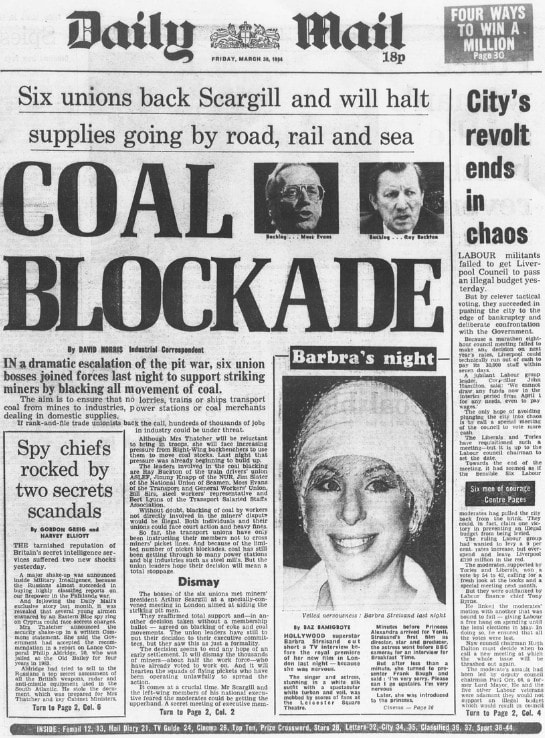
The Mirror, with its long and sometimes tumultuous history, played a pivotal role in shaping British journalism into what it is today. History, however, cannot be studied in a vacuum, and using only a single newspaper as an authoritative source produces an incomplete view of political and social events as they unfolded. From the Mirror’s innovative use of photography at the start of the twentieth century to the sensationalist headlines and leftist editorial stance of later years, the paper’sdeliberate editorial approach becomes even more apparent when viewed in comparison with the Daily Mail and its entirely different editorial stance. Only by using multiple sources alongside one another are researchers able to build a fully rounded understanding of any one period in modern history.
Want to read further analysis of newspaper archives and the way the media reflects and influences society? Check out: Contention in the British Press: WWI – Likelihood and Leadership, Contention in the British Press: The Rise of Fascism, and Cracking the Enigma Code: The Daily Telegraph’s Crossword Challenge.
Much of the content at the beginning of this blog post was based around Dr Adrian Bingham’s essay “An introduction to the Daily Mirror”, which you can read in full here.
Blog post cover image citation: “The Mirror.” Daily Mirror, 30 Oct. 2000, p. [1]. Mirror Historical Archive, 1903-2000, https://link.gale.com/apps/doc/VAGVHC431954064/GDCS?u=webdemo&sid=GDCS&xid=81696a64 combined with “The Daily Mirror.” Daily Mirror, 12 Nov. 1903, p. 3. Mirror Historical Archive, 1903-2000, https://link.gale.com/apps/doc/WUCZIO694924276/DMIR?u=webdemo&sid=DMIR&xid=d9f99f69

